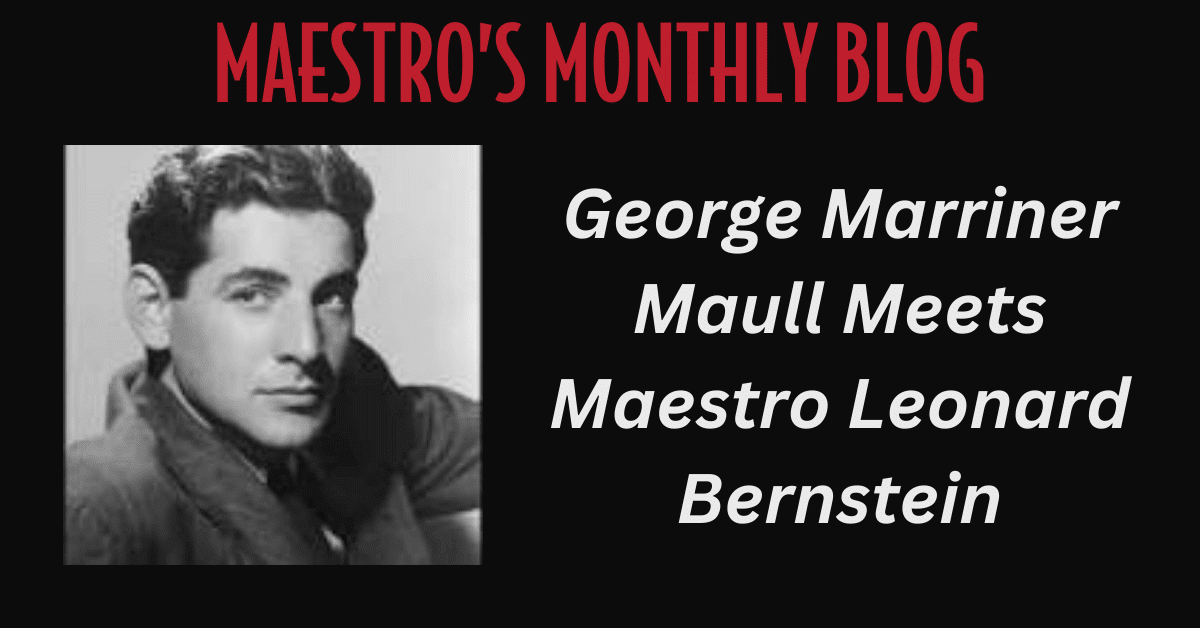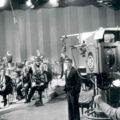Jan 19, 2024
George Marriner Maull Meets Maestro Bernstein…A Recollection

In light of the recent release of the film Maestro about Leonard Bernstein, I would like to share a few recollections of meeting him in 1976.
While residing in Louisville in the spring of 1975 at age 28, I had four posts – conductor of the Louisville Ballet, assistant conductor and chorus master of the Kentucky Opera, conductor of The Louisville Singers, and music director of The Heritage Theater of Louisville which mounted Broadway musical productions. But, I was very ambitious and wanted to do some conducting beyond the boundaries of the Commonwealth of Kentucky. My first wife, mezzo soprano Mary Lee Farris, a superb vocal recitalist and operatic singer who was on the faculty of the University of Louisville School of Music, also wished to expand her horizons. So we decided to resign from our positions in Louisville and move to New York City in the summer of 1975 to pursue our dreams.
Mary Lee, who has an exquisitely beautiful voice and is one of the most expressive singers I’ve ever known, obtained professional management as soon as we got to New York and began to be engaged as a soloist with orchestras and opera companies around the country. She also made her debut both at Carnegie Hall and Lincoln Center in the spring of 1976 as a soloist with the Oratorio Society of New York.
Not long after arriving in Manhattan, I wrote to Leonard Bernstein asking if I could study conducting with him. Never dreaming that I would actually hear from him, you can imagine the electrically-charged atmosphere in our apartment when, a month later, the phone rang and Mary Lee answered. Wide-eyed and holding her hand over the microphone end of the receiver, she said, “George, it’s someone from Leonard Bernstein’s office, calling to speak with you!”
Having barely a second to compose myself, I proceeded to make an appointment to meet Harry Kraut, who managed Maestro Bernstein’s professional life at a business entity known as Amberson Productions. Many years later, reading Jamie Bernstein’s Famous Father Girl, A Memoir of Growing Up Bernstein, I would learn that Harry was actually not one of her favorite persons, but he was very cordial on the occasion of our meeting.
Putting two and two together, I assumed that my letter detailing my conducting experience in Louisville had generated enough interest at Amberson for an interview with Harry, who undoubtedly also served as gatekeeper for Maestro Bernstein, keeping overly ambitious, obnoxious young conductors at bay. The Amberson Productions office was in a building near Carnegie Hall and an easy walk from our apartment on West 74th Street between Broadway and West End Avenue. On a beautiful Manhattan fall day, I ambled my way there – obsessively thinking, hoping…
Upon entering Harry Kraut’s office, I immediately walked by someone seated at the piano in a soundproof studio who was sight-reading an orchestral score, handwritten on manuscript paper. In 1975 there were, of course, no computers let alone computer programs designed to create and print out musical scores.The scorefor every new orchestral composition had to be handwritten. The last person I had seen sight-reading scores at the piano was Robert Whitney, former music director and conductor of The Louisville Orchestra. He regularly received stacks of manuscript scores from composers all over the world who hoped that Maestro Whitney might program their symphony or concerto on a Louisville Orchestra concert… and perhaps – even record it as part of the LO’s First Edition vinyl LP series. Sitting in the Amberson office before Harry was ready to see me, I thought to myself, “How many manuscript scores from composers must Leonard Bernstein receive each day?”
Harry indeed confirmed that Maestro Bernstein received so many scores he could not possibly read them all, and that Amberson hired pianists – like the one I’d passed on the way in – solely for the purpose of reading through these submissions, and then handing on to Maestro Bernstein those few scores that warranted a second look by him.
The interview lasted about 45 minutes, during which time Harry was able to ascertain that I didn’t reek of a vile aftershave lotion, nor was I mentally unstable or boring. His final question? “Why on earth do you want to be a conductor? It’s such a challenging, competitive career to attempt to have.” I said, as passionately as I could muster, something like “Because I am so moved by classical orchestral music and have been since early childhood.”
Then he said, “Maestro Bernstein is not accepting any conducting students at this time. He is in a writing phase and has dedicated large blocks of his time for composing. But… he would like to extend to you an invitation to attend his rehearsals and performances whenever he is in town guest conducting the Philharmonic. Your name will always be on a list at the stage door of Avery Fisher Hall or Carnegie Hall when he his rehearsing and performing there. Come whenever you can. The first opportunity will be the rehearsals for the subscription series beginning on March 26th.”
My feet walked back to our apartment, but to this day, I have no recollection of that walk home.
There are many stories I’d like to relate from the rehearsals I attended from 1976 until the summer of 1989 when my second wife Marcia and I moved to New Jersey. I even made some trips into the city after the move in order to attend some of Maestro Bernstein’s rehearsals until he died on my 43rd birthday, October 14th, 1990. Here a few.
On that first occasion when I arrived at the stage door of Avery Fisher Hall and gave them my name, the guard picked up a clipboard, and there it was… months after I’d conversed with Harry Kraut… George Marriner Maull. Amazing! Once in the hall, I met another young conductor, Jon Goldberg, who had been attending Maestro Bernstein’s rehearsals prior to my arrival in the city. He wanted to help me learn “the rules of the road,” for which I was most grateful. Among them? “Do NOT under any circumstance address Maestro Bernstein as ‘Lenny.’ That is a privilege reserved only for his closest friends and associates.” “OK!” I thought, and mentally filed that information.
There was often a cadre of young wanna-be conductors there – maybe five of us at most – but frequently there were just two or three. We sat in the hall during the rehearsals and were permitted to go to Maestro Bernstein’s dressing room during the breaks. There, he would dispense gems of wisdom – and I’m not at all being sarcastic – on a variety of subjects, music-related and otherwise, during those rehearsal breaks.
On a break in his dressing room, I learned one of “the rules of the road” the hard way. The young conductors never spoke to Maestro Bernstein unless spoken to. One could ask him a specific question, but unsolicited observations about music made by virtually anyone else in his dressing room were unwelcome and met with icy stares. I got the message.
Being in close proximity, I was able to observe firsthand Maestro Bernstein’s heavy smoking habit. At the time, I was still addicted to cigarettes, smoking three packs a day, and in no position to judge. Of course, no one else was permitted to smoke in his dressing room.
One of the things I envied about him most – beyond his enormous talents and monumental musical accomplishments – was that the fact that he had a personal assistant. John Walker carried Maestro Bernstein’s traveling bag containing his formal wear and also a valise containing his scores, batons, a bottle of Ballantine scotch, and a gold cup. John would pour cups of scotch for Maestro Bernstein without being asked. John also helped him adjust his attire. I thought to myself, “It must be nice!”
There were some very touching moments backstage. I can still see Maestro Bernstein and his wife, Felicia Montealegre, who sadly died in 1978, walking arm in arm down the corridors of Avery Fisher Hall. It was obvious how much they loved each other.
In 1976 Maestro Bernstein had written the score for a new musical, 1600 Pennsylvania Avenue, collaborating with lyricist Alan Jay Lerner of Lerner & Lowe – My Fair Lady fame. The show was about the occupants of the White House from 1800 to 1900. The musical opened on Broadway on May 4, 1976 and closed four days later after only seven performances, becoming a true Broadway disaster. By then I had known Maestro Bernstein for less than three months.

Apparently Maestro Bernstein had never seen it before, and it immediately brought a smile to his face. He thanked me for bringing it, handed the Rubinstein photo to John Walker, and said, “Tape this to my dressing room mirror” (at the ill-fated Mark Hellinger Theatre). Then, in a never-to-be repeated invitation, he asked me where I lived and if I wanted a ride home. I said on West 74th Street, but knowing that he lived in The Dakota on West 79th and Central Park West, I just asked to be dropped off on that corner. So taking a backstage elevator ride I’d never taken before to the Lincoln Center garage with Maestro Bernstein and his entire entourage, during which he said “This is one of the worst times of my life!”, we then proceeded to get into his black limo. I was glad that I’d been able to lift his spirits, if even for only a moment.
Several coincidences from this time … it turned out that conductor Jon Goldberg, mentioned above, was driving Maestro Bernstein’s limo! And sometime later, I played viola in a performance at CAMI Hall with the Endymion Ensemble which Jon had founded and served as music director. But the pièce de résistance? You can image how surprised I was when it turned out that Maestro Bernstein’s assistant, John Walker, lived in my building on 74th Street!
The truly inspiring part of the entire experience was listening to and savoring Maestro Bernstein’s every word about the music during rehearsals and in his dressing room. In April of 1976, he rehearsed and conducted performances of Aaron Copland’s Symphony No. 3, and they recorded it live. I vividly recall Maestro Bernstein saying to the New York Philharmonic members, “This work is still as fresh and wonderful as when Aaron wrote it.” And in Maestro Bernstein’s hands it was! And still is… I treasure my CD of that performance.
I had never played Copland’s Symphony No. 3 in an orchestra nor studied the score. Maestro Bernstein gave this music such a loving and simultaneously passionate, spirited approach… it was overwhelming, and Maestro Copland was on hand as well! I had not seen him in the flesh since I’d played under him nearly twenty years earlier when he guest conducted The Louisville Orchestra. It was a totally over-the-top experience for me to be in the presence of these two musical giants whom I admired so greatly!
Things were not always rosy. The New York Philharmonic players had developed a reputation for their bad behavior in rehearsals. In January of 1977, I was engaged as a member of the New York Philharmonic’s professional chorus (yes, I sang, too!), The Camerata Singers, prepared by choral conductor Abraham Kaplan. This was during that era before Westminster Choir College began their collaborations with the Philharmonic.
The Camerata Singers were performing Stravinsky’s Symphony of Psalms on one of the last sets of subscription concerts conducted by then outgoing music director Pierre Boulez, whom the members of the Philharmonic appeared to despise. Sparing the gory details, their behavior seemed to have deteriorated during his tenure to that of a seventh grade class with a substitute teacher. From where I was sitting in the chorus, nestled behind the orchestra, I was appalled. I had never seen a professional orchestra behave this way in my life!
And I’d also witnessed them misbehave with Maestro Bernstein on the podium. On that occasion, the orchestra members were talking incessantly whenever Maestro Bernstein stopped to address some technical issue. Finally, he asked them politely to stop talking. When they did not, Maestro Bernstein – in a very loud and pleading tone – said, “PLEASE – stop talking! What has happened to you? What has happened to my orchestra?” which he had led as music director for eleven seasons. That was an eye opening moment for me. These players could even be discourteous and rude to Leonard Bernstein?
Finally, there was the Maestro’s fabled memory. I suspect he had a photographic memory, but without question, he had one of the sharpest memories for names I had encountered. According to musical colleagues he had not seen for decades, their names would pop right out… “Kenny, how are you? So good to see you!” And from my own limited experience, there was the following exchange.
Maestro Bernstein did not converse with me to any great extent over the fourteen years I attended his rehearsals, although he seemed to be aware of my presence. Over the spring and summer of 1976, the New York Philharmonic undertook an extensive, multimillion dollar acoustical renovation of their concert hall. I remember some of Maestro Bernstein’s rehearsals in May, when the workers were banging on walls and what have you. In utter frustration at one point, Maestro Bernstein yelled, “Will you PLEASE STOP – BANGING!” They did.
But after the renovations were complete, one afternoon in November 1976 I happened to be the only young conductor sitting in the hall about twenty rows back in the orchestra section. Maestro Bernstein had not seen me for six months. Rehearsing the orchestra he suddenly stopped, turned around, looked in my direction and said, “George! Do you hear any difference in the acoustics?” “No,” I replied. To which he replied, “Neither do I,” and went back to rehearsing. How many names must have been stored in his mind for instant access? Astounding!
If you have not already done so, see the feature film Maestro!






